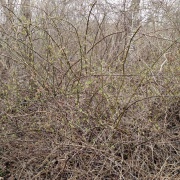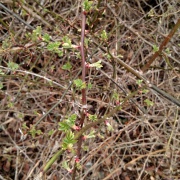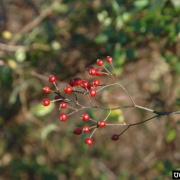Invasive in the Spotlight: Multiflora Rose

Native to Japan, Korea, and eastern China, multiflora rose (Rosa multiflora) was introduced into the United States in 1866 as rootstock for ornamental roses. It was also planted as a crash barrier in highway medians, as a means of providing erosion control, and as a source of food and cover for wildlife.
Multiflora rose is highly aggressive and readily colonizes old fields, pastures, roadsides, open woodlands, and forest edge habitats. It can also establish itself in forested sites where open gaps occur. It is most productive in sunny areas with well-drained soils.
Multiflora rose is a thorny perennial shrub with arching stems or canes. It grows to be six to ten feet tall and can reach fifteen feet. Its compound leaves have two inch long leaflets that are oval and toothed. Clusters of showy, white to pink, fragrant flowers bloom between May and June. The small, bright red fruits, referred to as rose hips, develop in the summer and remain on the bush through the winter.
There are two ways multiflora rose spreads. The first is through birds eating the fruit and distributing the seeds. These seeds can remain viable in the soil for up to 20 years. The second way multiflora rose spreads is through layering. Layering occurs when the cane tips touch the ground and grow roots, forming new plants.
Control
Individual small plants can be dug up or hand pulled. Efforts should be made to remove all of the roots to avoid resprouting. Continue to monitor areas where plants have been removed in the event regrowth occurs.
Large populations of multiflora rose can be treated with chemical controls. Herbicides can be effectively applied to both cut stems and foliage. Herbicides are most effective when applied to the surface of cut stems in early summer through winter. Applications made during the dormant season reduce the likelihood of damaging non-target species. Multiflora rose leafs out earlier than other native plants in the spring, at which time foliar applications can be made with little risk of damaging other plants.
References
NH Department of Agriculture: Multiflora Rose
NH Department of Agriculture: Control of Invasive Plants
Photos
UNH Cooperative Extension Master Gardener volunteers share information about home, yard, and garden topics with the people of New Hampshire. Got questions? Master Gardeners provide practical help finding answers to your questions through the Ask UNH Extension Infoline. Call toll free at 1-877-398-4769, Monday to Friday, 9 a.m. to 2 p.m., or e-mail us at answers@unh.edu.
Related Resource(s)







